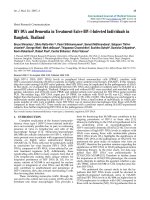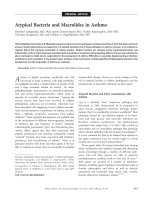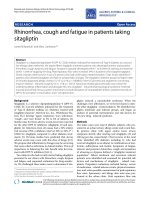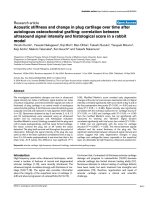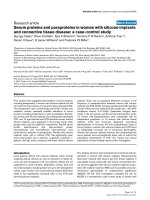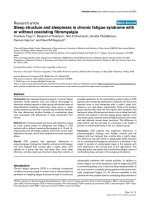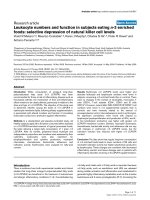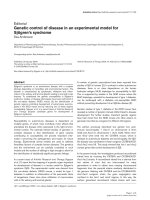Báo cáo y học: "Optimum sedation and analgesia in critical illness: we need to keep trying" pdf
Bạn đang xem bản rút gọn của tài liệu. Xem và tải ngay bản đầy đủ của tài liệu tại đây (31.56 KB, 2 trang )
433
ICU = intensive care unit; LOS = length of stay.
Available online />In a study reported in this issue of Critical Care, van de Leur
and colleagues [1] investigated the experience of critical
illness and intensive care unit (ICU) support from the
patient’s perspective. Although many workers have
documented memories of a period spent in the ICU, van de
Leur and coworkers attempted to relate memories of
discomfort in ICU to patients’ factual recall of the ICU.
Memories of the ICU were common (54%), supporting
previous findings [2,3]. Good factual recall was associated
with increased risk for having memories of physical and/or
psychological discomfort. The relative frequency of
hallucinations as a source of ICU discomfort (32%) appears
greater than that found by others [2,4], although it must be
highlighted that this is the percentage in the subset of
patients with recollection of the ICU – a stratification not
considered by other studies. Recollections of pain,
discomfort and other stressors suggest an undesirable
experience in ICU, and may be the origin of sleep
disturbances [2] and other (post-ICU) problems that affect
quality of life.
A significant strength of the study is the early assessment of
patients (within 3 days of ICU discharge) using a structured
questionnaire administered at a face-to-face interview. The
methodology is further enhanced by the use of an
assessment of factual recall in a matched control group of
general ward patients. The fact that they were interviewed
3 days after hospital discharge by telephone rather than face-
to-face is probably of little significance. The tool used to
assess factual recall was simple and would be easily
transferable between units.
The authors acknowledge that a lack of objective sedation
scoring was a weakness in the study. More detail on the
relative balance between the sedation and analgesia received
by study patients would also have been useful. The finding
that young patients have better factual recall and more
memory of discomfort may be due in part to a decreased
sensitivity to sedation/analgesia relative to older patients. It
may also be, in part, a reflection that younger patients may be
less intellectually impaired by a given physiological insult than
Commentary
Optimum sedation and analgesia in critical illness: we need to
keep trying
Gavin G Lavery
Director of Critical Care Services, Regional Intensive Care Unit, Royal Hospitals Trust, Belfast, UK
Corresponding author: Gavin G Lavery,
Published online: 3 November 2004 Critical Care 2004, 8:433-434 (DOI 10.1186/cc2998)
This article is online at />© 2004 BioMed Central Ltd
Related to Research by van de Leur et al., see page 513
Abstract
Many studies have documented patients’ distressing recollections of the intensive care unit (ICU). The
study by van de Leur and colleagues, conducted in a group of surgical ICU patients with moderate
severity of sickness, found that the frequency of such unpleasant memories was increased in those
able to recall factual information about their stay in the ICU. The study did not include sedation scoring
but it did use a simple tool to assess factual recall. This tool appeared reliable and could be easily
applied in any ICU. Previous work strongly suggests that abolishing memory of ICU by using deep
sedation would not be an appropriate response to these findings. Rather, we need to work on
strategies that reduce distress by improving analgesia, reducing noxious stimuli (if possible) and,
potentially, using pharmacology to produce a calm patient with minimal sedation. Achieving the latter is
rarely possible today but it might become possible with future drug development.
Keywords amnesia, critical care, hallucinations, recollection, sedation
434
Critical Care December 2004 Vol 8 No 6 Lavery
more elderly patients. A measure of the intensity of the
remembered discomfort would also be useful in a study of this
type (e.g. using a visual–analogue scale). We might judge the
recollection of occasional mild discomfort as a less worrying
problem and might even view it as (potentially) unavoidable.
Illness severity in this study was moderate, as evidenced by
the modest Acute Physiology and Chronic Health Evaluation
II scores on day 1, relatively short length of stay (LOS) in the
ICU, and the ability of almost all patients to complete a
structured interview within 3 days of ICU discharge. Although
this might be viewed as a weakness, it might in fact be a
strength because such patients, when interviewed during
recovery, may be expected to remember discomfort from a
previous phase of illness more accurately than patients with
high sickness severity scores with a long LOS in the ICU
[5,6].
A cynical view after reading this study (specifically the finding
that lack of factual recall was associated with less
recollection of discomfort) might be that it is better to use
deeper sedation in ICU patients. However, such sedative
practice has been shown to increase the duration of
mechanical ventilation and LOS in the ICU [7,8], which are
known risk factors for nosocomial pneumonia [9–11].
Absence of memory for a period may produce a condition
similar to post-traumatic stress disorder [6]. Therefore, the
use of high-dose sedation might be counterproductive in
terms of post-ICU psychological health. This appears to be a
significant ‘quality of life’ problem for many patients after
discharge from the ICU [12]. The use of diaries completed by
relatives and/or staff to reduce the memory deficit may be
useful in this context [13].
From this paper we may conclude that the ideal ICU sedative
regimen should produce good analgesia in a patient who is
‘tranquil’ but who retains mental clarity. Complementary to
good analgesia might be a reduction in noxious stimuli. van
de Leur and colleagues [14] previously suggested that
discomfort due to the presence of a tube in the trachea may
in fact be due to memories of tracheal suction. It is somewhat
surprising that chest physiotherapy was not identified as a
source of discomfort in postoperative surgical patients. We
need to explore the use of suction regimens that are limited
in terms of frequency or invasiveness in appropriate patients.
The finding that more than 50% of patients who remembered
the ICU had memories of discomfort is disappointing. To
evaluate this problem fully, we must study different patient
populations, using similar methodology to that used in the
study by van de Leur and colleagues, but including an
objective measure of sedation/analgesia and a means to
quantify the degree of discomfort remembered.
Competing interests
The author(s) declare that they have no competing interests.
References
1. van de Leur JP, van der Schans CP, Loef BG, Deelman BG,
Geertzen JHB, Swaveling JH: Discomfort and factual recollec-
tion in intensive care unit patients. Crit Care 2004, 8:R467-
R473.
2. Strahan E, McCormick J, Uprichard E, Nixon S, Lavery G: Imme-
diate follow-up after ICU discharge: establishment of a
service and initial experiences. Nurs Crit Care 2003, 8:49-55.
3. Rotondi A, Chelluri L, Sirio C, Mendelsohn A, Schultz R: Patients
recollections of stressful experiences while receiving pro-
longed mechanical ventilation in an intensive care unit. Crit
Care Med 2002, 30:746-752.
4. Holland C, Cason CL, Prater RL: Patients’ recollection in critical
care. Dimensions Crit Care Nurs 1997, 16:132-141.
5. Jones J, Hoggart B, Withey J, Donaghue K, Ellis BW: What the
patients say: a study of reaction to an intensive care unit.
Intensive Care Med 1979, 5:89-92.
6. Jones C, Griffiths RD, Humphris G: Disturbed memory and
amnesia related to intensive care. Memory 2000, 8:79-94.
7. Kress JP, Gehlbach B, Lacy M, Pliskin N, Pohlman AJ, Hall JB:
The long-term psychological effects of daily sedative interrup-
tion on critically-ill patients. Am J Respir Crit Care Med 2003,
168:1457-1461.
8. Schweikert WD, Gelbach BK, Pohlman AJ, Kall JB, Kress JP:
Daily interruption of sedative infusions and complications of
critical illness in mechanically ventilated patients. Crit Care
Med 2004, 32:1272-1276.
9. Rodriguez JL, Gibbons KJ, Bitzer LG, Dechert RE, Steinberg SM:
Pneumonia: incidence, risk factors, and outcome in injured
patients. J Trauma 1991, 31:907-912.
10. Cunnion KM, Weber DJ, Broadhead WE, Hanson LC, Pieper CF:
Risk factors for nosocomial pneumonia: comparing adult criti-
cal care populations. Am J Respir Crit Care Med 1996, 153:
158-162.
11. Tejada Artigas A, Bello Dronda S, Chacon Valles E, Munoz Marc
Villuendas Uson MC, Figueras P, Suarez FJ, Hernandez A: Risk
factors for nosocomial pneumonia in critically ill trauma
patients. Crit Care Med 2001, 29:304-309.
12. Cuthbertson BH, Hull A, Strachan M, Scott J: Post traumatic
stress disorder after critical illness requiring general intensive
care. Intensive Care Med 2004, 30:450-455.
13. Backman CG, Walther SM: Use of a personal diary written on
the ICU during critical illness. Intensive Care Med 2001, 27:
426-429.
14. Van de Leur JP, Zwaveling JH, Loef BG, Van der Schans CP:
Patient recollection of airway suctioning in the ICU: routine
versus a minimally invasive procedure. Intensive care Med
2003, 29:433-436.
